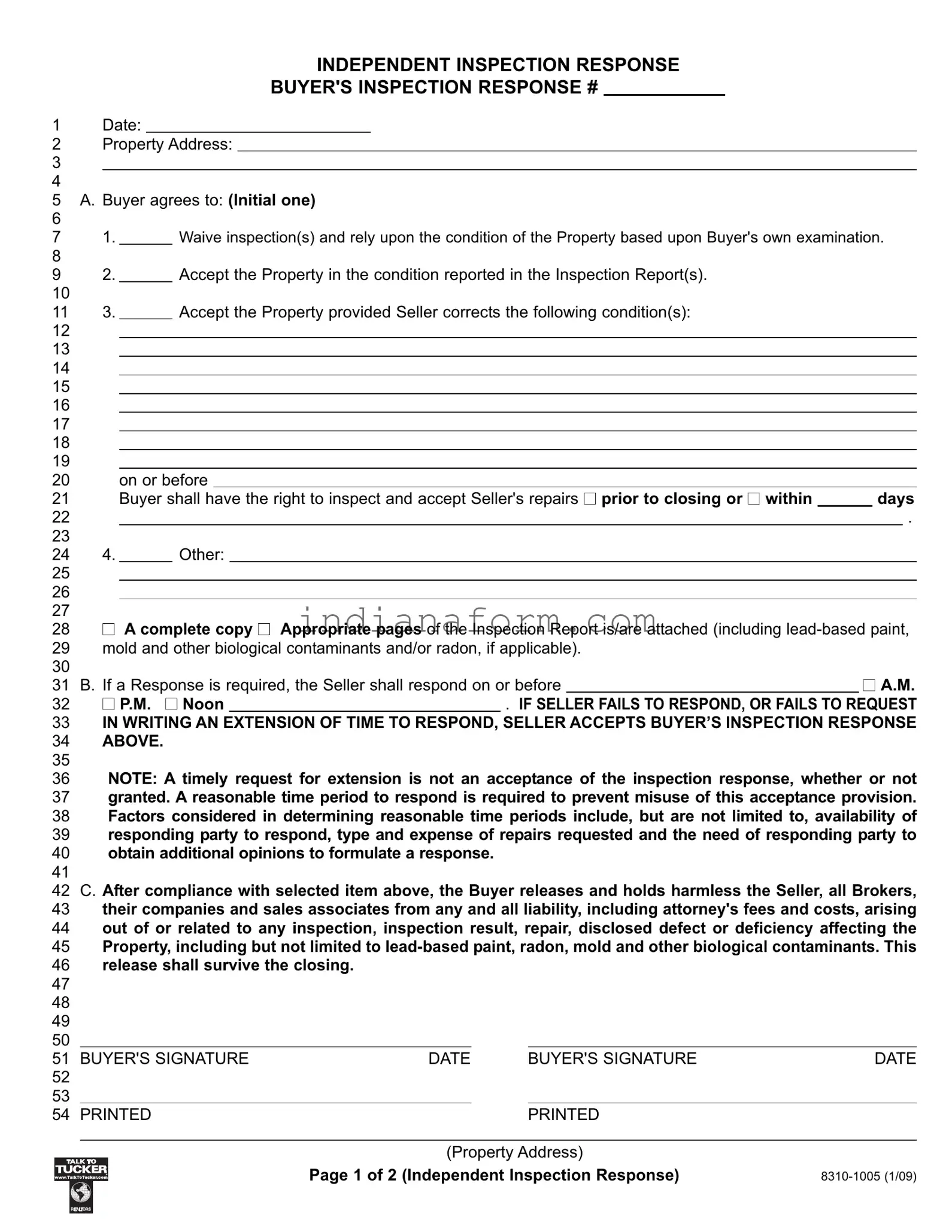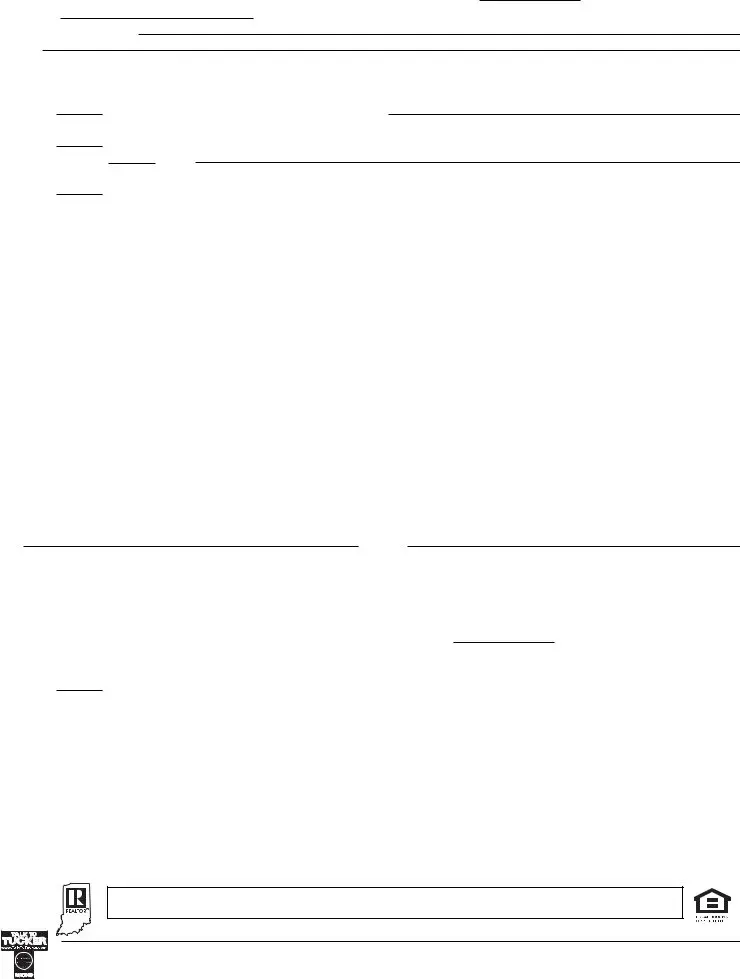INDEPENDENT INSPECTION RESPONSE
BUYER'S INSPECTION RESPONSE #
1Date:
2Property Address:
3
4
5 A. Buyer agrees to: (Initial one)
6
71. Waive inspection(s) and rely upon the condition of the Property based upon Buyer's own examination.
8
92. Accept the Property in the condition reported in the Inspection Report(s).
10
11 |
3. |
|
Accept the Property provided Seller corrects the following condition(s): |
|
|
|
12 |
|
|
|
|
|
|
|
|
13 |
|
|
|
|
|
|
|
|
14 |
|
|
|
|
|
|
|
|
15 |
|
|
|
|
|
|
|
|
16 |
|
|
|
|
|
|
|
|
17 |
|
|
|
|
|
|
|
|
18 |
|
|
|
|
|
|
|
|
19 |
|
|
|
|
|
|
|
|
20 |
|
on or before |
|
|
|
|
21 |
|
Buyer shall have the right to inspect and accept Seller's repairs ■ prior to closing or ■ within |
|
days |
22 |
|
|
|
|
|
. |
23 |
|
|
|
|
|
|
|
|
24 |
4. |
|
Other: |
|
|
|
25 |
|
|
|
|
|
|
|
|
26 |
|
|
|
|
|
|
|
|
27 |
|
|
|
|
|
|
|
|
28■ A complete copy ■ Appropriate pages of the Inspection Report is/are attached (including lead-based paint,
29mold and other biological contaminants and/or radon, if applicable).
30 |
|
|
|
|
|
31 |
B. If a Response is required, the Seller shall respond on or before |
|
■ A.M. |
32 |
■ P.M. ■ Noon |
|
. IF SELLER FAILS TO RESPOND, OR FAILS TO REQUEST |
33IN WRITINGAN EXTENSION OF TIME TO RESPOND, SELLERACCEPTS BUYER’S INSPECTION RESPONSE
34ABOVE.
35
36NOTE: A timely request for extension is not an acceptance of the inspection response, whether or not
37granted. A reasonable time period to respond is required to prevent misuse of this acceptance provision.
38Factors considered in determining reasonable time periods include, but are not limited to, availability of
39responding party to respond, type and expense of repairs requested and the need of responding party to
40obtain additional opinions to formulate a response.
41
42C. After compliance with selected item above, the Buyer releases and holds harmless the Seller, all Brokers,
43their companies and sales associates from any and all liability, including attorney's fees and costs, arising
44out of or related to any inspection, inspection result, repair, disclosed defect or deficiency affecting the
45Property, including but not limited to lead-based paint, radon, mold and other biological contaminants. This
46release shall survive the closing.
47 |
|
|
|
|
|
|
|
48 |
|
|
|
|
|
|
|
49 |
|
|
|
|
|
|
|
50 |
|
|
|
|
|
|
|
51 |
BUYER'S SIGNATURE |
DATE |
|
BUYER'S SIGNATURE |
DATE |
52 |
|
|
|
|
|
|
|
53 |
|
|
|
|
|
|
|
54 |
PRINTED |
|
|
PRINTED |
|
|
|
|
|
|
|
|
|
|
|
|
|
|
|
(Property Address) |
|
|
|
|
|
|
|
Page 1 of 2 (Independent Inspection Response) |
8310-1005 (1/09) |
|
|
|
|
|
|
|
|
|
|
55SELLER'S INSPECTION RESPONSE #
56Date:
57Property Address:
58
59
60A. Seller responds as follows: (Initial one)
621. Seller accepts Buyer's Inspection Response #
642. Seller agrees to correct condition(s) in item #3 ■ prior to closing the transaction or ■ within
65days
66
673. Seller is unable or unwilling to make the corrections requested by Buyer.
69 |
4. |
|
|
Seller agrees to correct the following condition(s) at Seller's expense ■ prior to closing the |
70 |
|
|
|
|
transaction or ■ within |
|
days |
|
|
71 |
|
|
|
|
|
|
|
|
|
|
|
72 |
|
|
|
|
|
|
|
|
|
|
|
73 |
|
|
|
|
|
|
|
|
|
|
|
74 |
|
|
|
|
|
|
|
|
|
|
|
75 |
|
|
|
|
|
|
|
|
|
|
|
76 |
5. |
|
|
Other: |
|
|
|
|
|
77 |
|
|
|
|
|
|
|
|
|
|
|
78 |
|
|
|
|
|
|
|
|
|
|
|
79 |
B. If a Reply is required, the Buyer shall reply on or before |
|
■ A.M. ■ P.M. ■ Noon |
80 |
|
|
|
|
|
|
|
. IF BUYER FAILS TO REPLYOR FAILS TO REQUEST IN WRITINGAN |
81EXTENSION OF TIME TO REPLY, BUYERACCEPTS SELLER’S INSPECTION RESPONSEABOVE.
83NOTE: A timely request for extension is not an acceptance of the inspection response, whether or not
84granted. A reasonable time period to respond is required to prevent misuse of this acceptance provision.
85Factors considered in determining reasonable time periods include, but are not limited to, availability of
86responding party to respond, type and expense of repairs requested and the need of responding party to
87obtain additional opinions to formulate a response.
90 |
SELLER'S SIGNATURE |
DATE |
SELLER'S SIGNATURE |
DATE |
91 |
|
|
|
|
|
92 |
|
|
|
|
|
93 |
PRINTED |
|
|
PRINTED |
|
94 |
|
|
|
|
|
95BUYER'S INSPECTION REPLY #
96A. Buyer replies as follows: (initial one)
97
981. Buyer accepts Seller's Response.
100 |
2. |
|
SEE BUYER'S INSPECTION RESPONSE # |
. |
|
|
101 |
|
|
|
|
|
|
|
|
|
|
|
102 |
3. |
|
Other: |
|
|
|
|
|
. |
103 |
|
|
|
|
|
|
|
|
|
|
|
104 |
|
|
|
|
|
|
|
|
|
|
|
105BUYER'S SIGNATURE |
DATE |
|
BUYER'S SIGNATURE |
DATE |
106 |
|
|
|
|
|
|
|
|
|
|
|
107 |
|
|
|
|
|
|
|
|
|
|
|
108PRINTED |
|
|
|
|
|
PRINTED |
|
|
Approved by and restricted to use by members of the Indiana Association of REALTORS®, Inc.
This is a legally binding contract, if not understood seek legal advice. Form #17B. Copyright IAR 2009
(Property Address) |
|
Page 2 of 2 (Independent Inspection Response) |
8310-1005 (1/09) |


